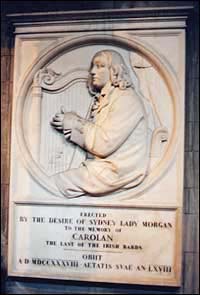
Home
Harper's Bizarre
by Tom Crann
March 2002
taken from the "Plugged In" supplement of Minnesota Monthly magazine
 |
 |
 |
© Dennis Doyle
A memorial for Turlough O'Carolan at St. Patrick's Cathedral in Dublin. |
 |
 |
About Carolan's Music
Carolan is said to have synthesized the Italian baroque style of Corelli and Geminiani with the Irish traditional harp style. His music is where folk intersects with baroque.
LISTEN: Compare the styles of Geminiani and Carolan.
Carolan and the Italian composer and violinist Francesco Geminiani (1687-1762) shared a mutual admiration of each other's musical gifts. An oft-told anecdote is that they met for a musical duel. (It was a draw.) I've scoured our musical references in the MPR library to find confirmation of this famous meeting, and simply can't. No matter. It's a durable legend, evocatively retold by Keenan in his novel, Turlough.
Repaying a "Debt of Gratitude"
In writing Turlough (available at Amazon.co.uk), Brian Keenan repays what he calls a "debt of honor" to Turlough O'Carolan for sustaining him as a hostage in Beirut in the late '80s.
LISTEN: Keenan reads an excerpt from Turlough.
The book is a rich, dark tapestry of several episodes in Carolan's life. As a musician, he was as comfortable in the raucous company of McGrattan's Pub as he was playing for the landed gentry of the grand Irish estates. He was also friendly with the writer Jonathan Swift, the dean of St. Patrick's Cathedral, Dublin.
|
The host of Sounds Irish tells how two staples of Irish culture meet on this year's program.
A change is as good as a rest. That's what they say in Ireland, anyway. So in 1986, Brian Keenan left his hometown of Belfast, Northern Ireland, for Beirut, Lebanon, to teach literature at the American University there.
Shortly after he arrived, he was taken hostage by Shi'ite terrorists and was held captive for nearly five years, enduring brutal deprivation. Though much of his ordeal included solitary confinement, he was visited by one man, Turlough O'Carolan—an Irish harper who died in 1738.
 |
 |
© Caroline Forbes
Author Brian Keenan |
Last year, trawling for ideas and background on O'Carolan to include in this year's Sounds Irish program, an Internet search introduced me to Keenan, who had written a novel based on the life of Carolan, as he's called.
"Tell My Story"
A novel? That's unusual. Surely, the life and times of a blind itinerant harper in rural Ireland of the 17th and 18th centuries is fecund with possibilities for historical fiction, but the contemporary story of how Keenan came to know this figure was even more compelling. I put Keenan at the top of my list of people to meet and talk to on a recent trip to Ireland to gather material for the program.
Keenan is a quiet, convivial, intelligent man with a gift for telling his story—which, he told me, is Carolan's story. Turlough O'Carolan (1670-1738), whom Keenan calls the "Jimi Hendrix of his day," appeared to Keenan throughout those dark days in Beirut to keep him company.
All Keenan had at his disposal were the power and imagery of his own mind. That's it. So he seized on the presence of Carolan for stimulation, company, and, being Irish, the great story. Keenan says outright that Carolan was saying to him: "Tell my story." He constantly wondered: "Am I imagining this or is it being told to me?"
Plucking and Winking
While Carolan is an undeniable figure in Irish musical circles, Keenan grew up protestant in working-class Belfast (around the corner from where my grandfather had grown up 50 years earlier, as we discovered). His exposure to Carolan, and to Irish traditional music and culture was minimal. It certainly was not what it would have been if he'd grown up in the west of Ireland, the center of Irish traditional music and dance.
 |
 |
© Dennis Doyle
A statue of Turlough O'Carolan in Mohill, Country Leitrim, Ireland. |
Funny enough, Keenan says he didn't hear any music when Carolan visited him. So, when he got back to Ireland after his time in captivity, he began to steep himself in recordings of Carolan's music. While he listened, he says he could see the harper plucking away, winking at him saying: "See! Now tell my story."
Past Meets Present
Unless you're a real devotee of Irish music, you might never have heard of Carolan. But his influence is still vivid in the culture today in other ways. And I don't just mean in Irish culture. A quick Web search pulls up sites from the Italian Associazione Turlough O'Carolan to O'Carolan's Pub in Tokyo. Obviously, his legacy extends beyond the island where he lived and played.
The Irish are master storytellers, and they have a great expression: It's all in the tellin'. I think you'll find that true when you hear Brian Keenan tell his unusual tale, and how it intersects with the story of a blind Irish harper who died in 1738, on Sounds Irish.
|



